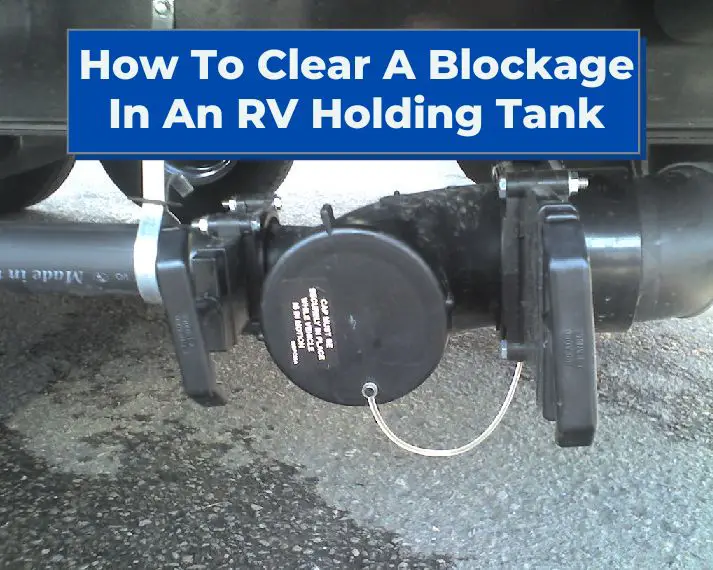RVing is a popular way to travel and see the country, but it comes with its own set of challenges. One of the nastiest issues RVers face is a clogged holding tank in their RV toilet. This can cause unpleasant odors, slow draining, and even backups. Knowing how to clear blockage in an RV holding tank is important for keeping your RV toilet and holding in good working order.
In this guide, we’ll cover different ways your holding tank can clog, how to fix them, and how to prevent future clogs from happening.
Types Of RV Black Tank Clogs
RV black tank clogs can be caused by various factors. Identifying the type of clog is crucial in determining the best method to clear it. Here are some common types of RV black tank clogs:
Pipe Clog
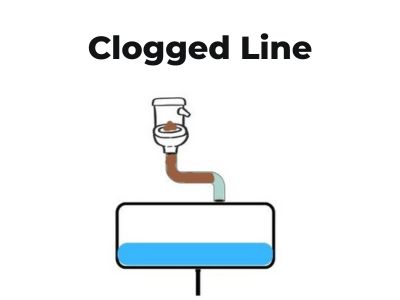
A pipe clog occurs when the waste pipe leading from the RV to the black tank becomes obstructed. This can be caused by a buildup of toilet paper, feminine hygiene products, or other debris. Flushing hot water down the pipe may help dislodge the blockage.
Poop Pyramid Clog
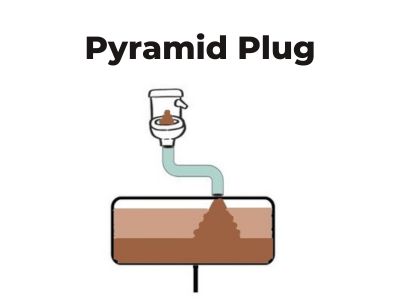
A poop pyramid clog happens when solid waste accumulates in the bottom of the tank, forming a pyramid-shaped blockage. This can occur when the tank is not emptied regularly or when too much toilet paper is used. Using a tank cleaner or enzyme treatment can help break down the solids and prevent future clogs.
Hardened Solids or Compacted Tank
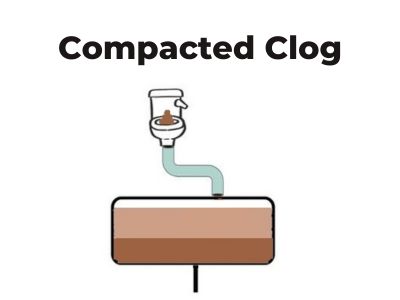
Over time, solid waste can harden and adhere to the walls of the tank, causing a clog. This can also happen when the tank is not emptied regularly or when using low-quality toilet paper. In severe cases, the tank may need to be professionally cleaned or replaced. Be sure to use the proper kind of toilet paper for RV toilets.
Misreading Sensors
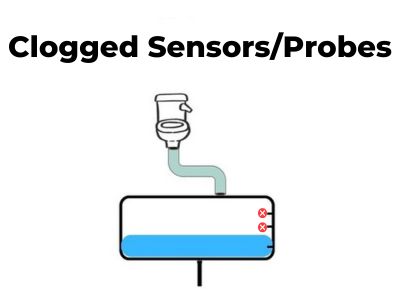
RV black tanks are equipped with sensors that indicate the level of waste in the tank. However, these sensors can become coated with waste and give inaccurate readings. This can lead to overfilling the tank and causing a clog. Regularly cleaning the sensors can prevent this issue.
Storing Without Dumping
Leaving waste in the tank for extended periods without dumping can cause a clog. This is because the waste can dry out and harden, making it difficult to remove. It is recommended to dump the tank regularly, even if it is not full.
Method 1: Forced Water Method
One of the most effective ways to clear a blockage in an RV toilet holding tank is by using the Forced Water Method for a black tank flush. This method involves using a water hose to force water into the tank and push the blockage out. Here’s how to do it:
- Connect one end of your water hose to a water source and the other end to the RV toilet.
- Set the water pressure to moderate or high.
- Turn on the water and let it run for a few minutes.
- If the blockage doesn’t clear, turn off the water and wait for a few minutes.
- Turn the water back on and repeat the process until the blockage clears.
It’s important to note that this method may not work for all types of blockages. If the blockage is too severe, you may need to try other methods or seek professional help.
Additionally, it’s important to use caution when using this method to avoid damaging the RV toilet or holding tank. Make sure to follow the instructions carefully and use the appropriate water pressure to avoid causing any damage.
Method 2: Pour Hot Water Down The Toilet
Another effective method to clear blockage in an RV toilet holding tank is to pour hot water down the toilet. This is a simple yet effective technique that can help dislodge any stubborn clogs in the tank.
To use this method, you will need to heat a pot or kettle of water on the stove until hot. Carefully pour it down the toilet bowl. Be sure to pour the water slowly and steadily to avoid splashing or overflowing the bowl.
Be careful not to use water that’s too hot, as it can damage your RV toilet or the seal on it.
After pouring the water down the toilet, wait for a few minutes to allow the hot water to work its way through the tank and break up any blockages. Then, flush the toilet to see if the clog has been cleared. If the water drains normally, then the blockage has been successfully removed.
It’s important to note that this method may not work for all types of blockages. If the clog is caused by solid waste or other large objects, then it may require a more powerful technique to remove the blockage. However, pouring water down the toilet is a safe, cheap, and effective method to try before resorting to bigger measures.
Method 3: Try To Snake The Clog Out
Using a snake, drain auger, or even a broom handle, you can attempt to dislodge a clog by sticking the tool of your choice right down the RV toilet opening and see if you can move anything around.
Just be careful so you don’t damage your toilet or the connected plumbing.
Method 4: Add Clog Digesters To Your Black Water Tank
Another effective way to clear a clogged RV toilet holding tank is to add clog digesters to your black water tank. These products are designed to break down waste and tissue paper, making it easier for them to flow through the pipes and preventing blockages.
There are various types of clog digesters available in the market, including enzyme-based and bacteria-based products. Enzyme-based digesters use natural enzymes to break down the waste, while bacteria-based digesters use live bacteria to consume the waste and convert it into harmless byproducts.
When using clog digesters, it’s important to follow the manufacturer’s instructions carefully. Typically, you’ll need to add the product to your black water tank and let it sit for a few hours or overnight. The product will then break down the waste, making it easier to flush out the tank.
It’s important to note that clog digesters are not a substitute for regular tank maintenance. To prevent clogs from occurring in the first place, it’s important to properly maintain your RV toilet holding tank. This includes regularly flushing the tank with clean water, using RV-safe toilet paper, and avoiding flushing non-biodegradable items down the toilet.
Method 5: Take a Drive
Sometimes the natural movement and “sloshing around” inside the tank can naturally break up the solids if everything’s been stationary for a while.
So take a drive for a bit and see if that helps
Method 6: Use Ice Cubes
Another effective method for clearing blockages in an RV toilet holding tank is to use ice cubes. This method is similar to the boiling water method, but instead of using hot water, you use frozen water to create a powerful force to push through the clog.
To use this method, start by filling the toilet bowl about one-third full of water. Then, add as many ice cubes as you can to the bowl before flushing them down. Repeat this process a few more times until the ice cubes have pushed through the blockage and the water is flowing freely.
This method is effective because the ice cubes create a powerful force as they melt and move through the tank. Additionally, this method is safe for your RV’s plumbing system and can be used regularly to keep your holding tank clean and clear.
Some folks recommend combining ice cubes and driving around, as the movement of the ice cubes can help break up the solids in the black tank.
Method 7: Try Dawn Dish Soap
If the previous methods have failed, you can try using Dawn dish soap to clear the blockage in your RV toilet holding tank. This method is simple, and you may already have the necessary supplies on hand.
To begin, pour a generous amount of Dawn dish soap into your toilet bowl and flush it down so it goes into your RV’s black tank. The amount you use will depend on the severity of the blockage, but ¼ to ⅓ cups should be enough. Allow the soap to sit in the tank for several hours before attempting to flush it out.
Next, add hot water. Be careful not to use boiling water, as this can damage your RV’s plumbing system. Slowly pour the hot water into the bowl, and allow it to mix with the dish soap in the tank. The combination of dish soap and hot water should help break up the blockage and allow it to flow through your RV’s plumbing system.
Method 8: Flush With Pressurized Water
If the blockage in the RV toilet holding tank is severe, flushing with pressurized water may be necessary. This method involves using a specialized tool to blast water through the tank and break up the blockage.
To use this method, you will need a pressurized water wand or a tank rinser. These tools hook up to standard garden hose and shoot high-pressure water into the holding tank.
Begin by attaching the water wand or rinser to the garden hose and inserting it into the toilet bowl. Turn on the water and allow the tool to blast water into the tank for several minutes.
After a few minutes, turn off the water and remove the tool from the toilet bowl. Allow the water to drain out of the holding tank and check to see if the blockage has been cleared.
Repeat several times if necessary, making sure to direct the water flow towards different areas of the tank to break up any stubborn blockages.
It is important to note that using pressurized water to clear a blockage in an RV toilet holding tank can be messy and may result in water splashing out of the tank. It is recommended to wear protective clothing and eyewear to avoid getting wet.
Preventing Future Blockages
Prefill Your RV Toilet
One way to prevent future blockages is to prefill your RV toilet before using it. This means adding water to the bowl before using it for solid waste. Adding water to the bowl before use can help prevent waste from sticking to the sides of the bowl and causing a blockage.
Flush For Ten Seconds
Another way to prevent blockages is to flush your RV toilet for ten seconds after each use. This helps ensure that all waste is flushed out of the bowl and pipe and into the holding tank.
Always Keep Your Tank Valve Closed
Always keep your RV black tank valve closed, except when dumping. Leaving your tank valve open allows all the fluid to drain out, but leaves the solids behind, which can harden and cause a blockage.
Regular Tank Maintenance
Regular tank maintenance is also important in preventing future blockages. This includes using a tank cleaner regularly, as well as flushing the tank with water after each use. Additionally, it is important to have your tank inspected and cleaned by a professional on a regular basis to ensure that it is functioning properly.
By following these simple steps, RVers can help prevent future blockages in their RV black water tanks.
Check out our other helpful RV repair and troubleshooting guides while you’re here:
What to do if your RV toilet isn’t holding water

